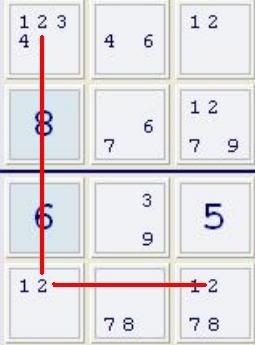I could solve this SE=8.4 rated
- Code: Select all
000050002070000090400800000100600800906000305002004007000003006090010070500020000
using ariadne's thread like long forcing chains, starting on the bi-value cells.
Using more analytical methods, I get stuck at this point:
- Code: Select all
*--------------------------------------------------------------------*
| 368 1368 1389 | 1347 5 179 | 1467 13468 2 |
| 2368 7 135 | 1234 46 12 | 1456 9 138 |
| 4 1236 159 | 8 67 1279 | 1567 35 13 |
|----------------------+----------------------+----------------------|
| 1 34 7 | 6 39 5 | 8 2 49 |
| 9 48 6 | 12 78 1278 | 3 14 5 |
| 38 5 2 | 19 38 4 | 169 16 7 |
|----------------------+----------------------+----------------------|
| 7 128 148 | 459 489 3 | 1245 1458 6 |
| 2368 9 348 | 45 1 68 | 245 7 348 |
| 5 1368 1348 | 47 2 678 | 149 1348 13489 |
*--------------------------------------------------------------------*
I know there are some short forcing chains, but I'm more interested in other methods to solve this one.


